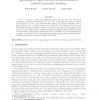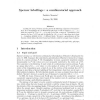TVCG
2008
14 years 10 days ago
2008
In many information visualization techniques, labels are an essential part to communicate the visualized data. To preserve the expressiveness of the visual representation, a placed...
JCO
2007
14 years 10 days ago
2007
Let G = (V, E) be a connected multigraph, whose edges are associated with labels specified by an integer-valued function L : E → N. In addition, each label ℓ ∈ N has a non-...
JANCL
2007
14 years 10 days ago
2007
Logic of proofs LP introduced by S. Artemov in 1995 describes properties of proof predicate “t is a proof of F” in the propositional language extended by atoms of the form [[t...
TCOM
2008
14 years 10 days ago
2008
Most network operators have considered reducing Label Switched Routers (LSR) label spaces (i.e. the number of labels that can be used) as a means of simplifying management of under...
SYNTHESE
2008
14 years 10 days ago
2008
Abstract We argue that in the decision making process required for selecting assertible vague descriptions of an object, it is practical that communicating agents adopt an epistemi...
PAMI
2006
14 years 11 days ago
2006
Multiple-instance problems arise from the situations where training class labels are attached to sets of samples (named bags), instead of individual samples within each bag (called...
JMLR
2006
14 years 12 days ago
2006
A selective sampling algorithm is a learning algorithm for classification that, based on the past observed data, decides whether to ask the label of each new instance to be classi...
JMLR
2006
14 years 12 days ago
2006
We discuss the problem of learning to rank labels from a real valued feedback associated with each label. We cast the feedback as a preferences graph where the nodes of the graph ...
JMLR
2006
14 years 12 days ago
2006
A classical approach in multi-class pattern classification is the following. Estimate probability distributions that generated the observations for each label class, and then labe...
JCT
2006
14 years 12 days ago
2006
In 2002, De Loera, Peterson and Su proved the following conjecture of Atanassov: let T be a triangulation of a d-dimensional polytope P with n vertices v1, v2, . . . , vn; label t...




